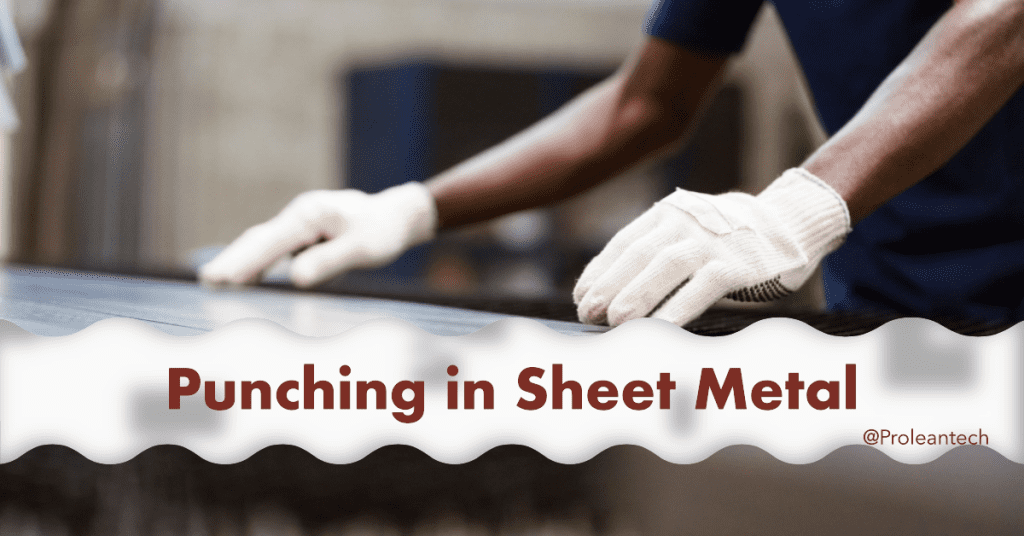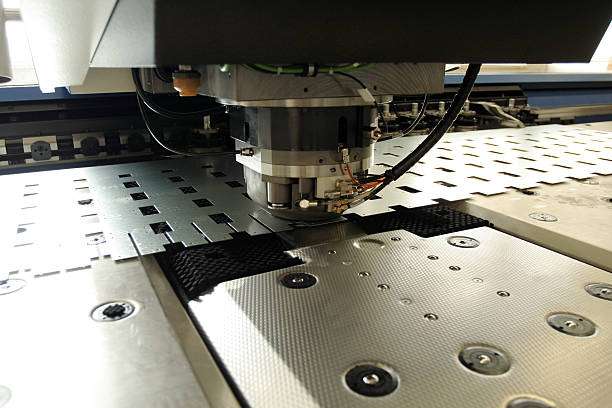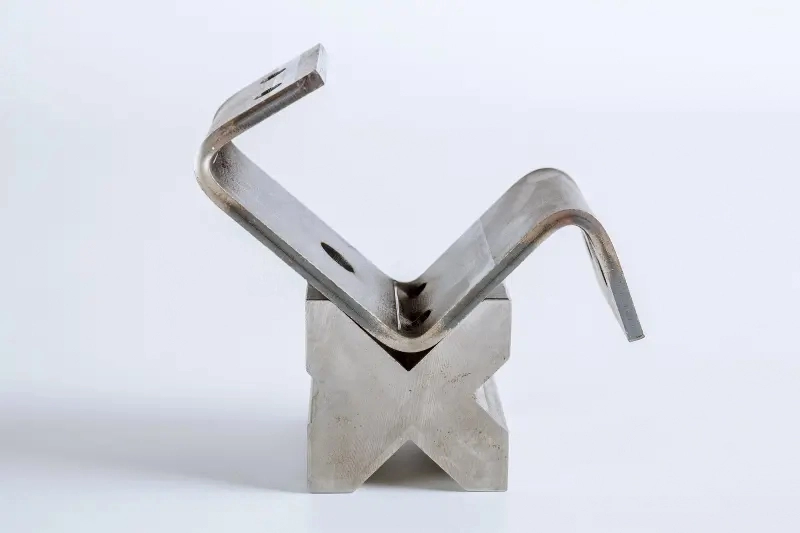
Punching in sheet metal has been a common fabrication technique for centuries. It involves creating holes or shapes in sheet metal by forcing a tool called a punch through the material and into a die. The process is typically performed on a press machine, which applies force to the punch to create the desired shape. With the advancements in technology and the need for more accurate and efficient operations, punching in sheet metal has evolved into a highly sophisticated process, ensuring improved productivity and quality in sheet metal fabrication.
In this article, We will discuss sheet metal punching techniques, productivity strategies, technology and automation, common issues and solutions, and future trends in sheet metal fabrication.
Understanding the Sheet Metal Punching Process

High-precision CNC sheet metal stamping and punching machinery.
Sheet metal punching
Before delving into the advanced techniques and strategies for improving productivity and quality in sheet metal punching, it is essential to have a solid understanding of the sheet metal punching process. This involves understanding the steps involved, the factors that can affect the quality and efficiency of the process, and the importance of proper punch and die maintenance.
Now, let’s overview the sheet metal punching process and the factors that can influence its success.
1. Sheet Metal Punching Process Overview
The sheet metal punching process can be broken down into several steps. Firstly, the sheet metal is placed on a work surface or table, with the punch and die aligned above and below the material, respectively. As force is applied to the punch, it moves downward, forcing the sheet metal into the die. The metal is then sheared or cut by the sharp edges of the punch and die, creating a hole or shape in the material. The process is typically performed on a press machine, which can be either manually or mechanically operated.
2. Factors Affecting the Punching Process
Several factors can influence the quality and efficiency of the sheet metal punching process. These include the type and thickness of the material being punched, the size and shape of the punch and die, the alignment of the punch and die, the force applied to the punch, and the speed of the operation. To achieve optimal results, it is crucial to understand the interplay between these factors and make adjustments as needed.
3. Importance of Proper Punch and Die Maintenance
Maintaining the punch and die is essential for ensuring the accuracy and longevity of the punching process. Regular maintenance includes cleaning, sharpening, and lubricating the tools, as well as inspecting them for signs of wear and tear. Damaged or worn tools can lead to a decline in the quality of the punched material and may even cause damage to the press machine.
Sheet Metal Die Punch: Basics and Types
A sheet metal die punch is a tool used in the punching process to create holes or shapes in sheet metal. It consists of a cutting edge, which shears the material, and a body, which supports and guides the cutting action. The die punch is typically made from hardened steel or carbide to withstand the stresses of the punching process.
Types of Die Punches
There are various types of die punches, each designed for specific applications and materials. Some common types include:
- Standard die punches: These punches are used for creating simple holes or shapes in sheet metal. They have a straight cutting edge and can be round, rectangular, or square in shape.
- Forming die punches: Forming punches are designed to create complex shapes or features in sheet metal, such as louvers, embossments, or countersinks. They have a shaped cutting edge that matches the desired form.
- Turret die punches: Turret punches are used in combination with a turret press machine. They have multiple punch and die sets mounted on a rotating turret, allowing for rapid tool changes and increased productivity.
Advanced Strategies for Improved Productivity in Sheet Metal Punching
When it comes to improving productivity in sheet metal punching, there are several advanced strategies that can be utilized. These include optimizing punch and die selection, implementing nesting techniques, and leveraging high-speed punching methods.
- Optimizing punch and die selection
To enhance productivity in sheet metal punching, it is crucial to select the appropriate punch and die for the specific application and material. This involves considering factors such as the material type, thickness, and desired hole or shape size. Using the correct tools can help minimize wear, reduce the risk of damage to the material or press machine, and improve the overall efficiency of the operation.
- Implementing nesting techniques
Nesting refers to the arrangement of parts to be punched on a sheet metal workpiece in a manner that maximizes material utilization and minimizes waste. Advanced nesting techniques, such as dynamic nesting and common line cutting, can significantly improve productivity by reducing material waste and the time required for the punching process.
- Leveraging high-speed punching techniques
High-speed punching techniques, including servo-electric punching and high-performance hydraulic punching, can significantly increase the speed and efficiency of the sheet metal punching process. These advanced technologies enable faster punch speeds, reduced cycle times, and increased productivity.
Enhancing Quality in Sheet Metal Fabrication through Precise Die-punch Selection

Die & Punch
Choosing the right punch and die for the specific application and material can play a significant role in enhancing the quality of sheet metal punching. This involves considering factors such as the material type, thickness, and desired hole or shape size. Additionally, coatings and surface treatments can also help improve the surface finish of the punched material, reducing the need for post-processing.
1. Importance of punch and die selection for quality
The quality of the punched sheet metal is heavily influenced by the precision and condition of the punch and die. Choosing the right tools for the specific application and material can help ensure clean, accurate cuts and minimize the risk of defects, such as burrs, cracks, or deformation.
2. Considerations for selecting the appropriate die punch
When selecting a die punch, it is essential to consider factors such as the material type, thickness, and desired hole or shape size. Other factors, such as the punch and die clearance, the tool’s geometry, and the material’s hardness and ductility, can also impact the quality of the punched material.
3. The Role of coatings and surface treatments
Coatings and surface treatments can play a significant role in enhancing the quality of sheet metal punching. Applying a coating or treatment to the punch and die can help reduce friction, minimize wear, and extend the life of the tools. Additionally, coatings and treatments can help improve the surface finish of the punched material, reducing the need for post-processing.
The Role of Software in Optimizing the Sheet Metal Punching Process
Design software for sheet metal fabrication
Design software plays a critical role in the sheet metal fabrication process by enabling the creation of accurate, detailed designs and facilitating the seamless transfer of data between different stages of the fabrication process. Modern design software programs offer a range of advanced features, such as parametric modeling, simulation tools, and automated nesting capabilities, which can help optimize the sheet metal punching process.
CAD/CAM integration for improved productivity
Integrating computer-aided design (CAD) and computer-aided manufacturing (CAM) systems can significantly improve the efficiency and accuracy of the sheet metal punching process. This integration allows for seamless data transfer between the design and manufacturing stages, reducing the risk of errors and ensuring that the punched parts meet the required specifications.
Utilizing simulation and analysis tools
Simulation and analysis tools can play a vital role in optimizing the sheet metal punching process by enabling the identification of potential issues before they become costly problems. By simulating the punching process, it is possible to evaluate factors such as tool wear, material deformation, and punch force requirements, allowing for adjustments to be made before the actual fabrication process begins.
Automating the Punching Process: Benefits & Challenges
Automation has transformed the sheet metal punching process, offering numerous benefits, such as increased productivity, improved accuracy, and reduced labor costs. Automated punching machines can perform complex tasks quickly and consistently, minimizing the risk of errors and ensuring that the fabricated parts meet the required specifications.
1. Challenges of automating the punching process
While automation offers many advantages, it also presents some challenges. One of the main challenges is the initial investment required to purchase and install automated equipment. Additionally, there may be a learning curve associated with adopting new technology, as well as ongoing maintenance and support costs.
2. Balancing automation and manual labor
In many cases, a combination of automated and manual labor can be the most effective approach to sheet metal punching. While automation can handle repetitive tasks and complex operations efficiently, manual labor can be more suitable for smaller-scale production or tasks that require a high degree of customization.
Preventing Common Issues in Metal Sheet Punching
| Steps | Recommendations | Benefits |
|---|---|---|
| Identifying potential issues | Early identification of issues can prevent costly mistakes and ensure punched parts meet the required specifications | Improved quality, cost savings |
| Implementing preventive measures | Regular tool maintenance and inspection, using an appropriate punch and die, ensuring proper alignment and clearance | Minimizes risk of issues arising during the punching process |
| Utilizing advanced technologies and techniques | High-speed punching, coatings and surface treatments, software tools | Enhances efficiency and quality of the punching process |
Sheet Metal Punching at ProleanTech
ProleanTech specializes in sheet metal fabrication, offering a wide range of services, including punching, laser cutting, bending, and assembly. With extensive experience and a commitment to quality, we can help ensure the success of your sheet metal fabrication project. If you need punching or any other fabrication services, Contact us Today!
Conclusion
The sheet metal punching process is a critical component of the fabrication industry, with advanced strategies and technologies playing a vital role in improving productivity and quality. By understanding the intricacies of the process, selecting the appropriate tools and techniques, and leveraging the latest innovations, it is possible to optimize the punching process and ensure the success of sheet metal fabrication projects.
FAQ’s
Q: What is punching in sheet metal?
A: Punching in sheet metal is a fabrication technique that involves creating holes or shapes in sheet metal by forcing a tool called a punch through the material and into a die.
Q: What factors affect the sheet metal punching process?
A: Factors affecting the sheet metal punching process include the type and thickness of the material being punched, the size and shape of the punch and die, the alignment of the punch and die, the force applied to the punch, and the speed of the operation.
Q: What are some advanced strategies for improving productivity in sheet metal punching?
A: Advanced strategies for improving productivity in sheet metal punching include optimizing punch and die selection, implementing nesting techniques, and leveraging high-speed punching methods.
Q: How can software help optimize the sheet metal punching process?
A: Software can help optimize the sheet metal punching process by enabling the creation of accurate designs, facilitating seamless data transfer between fabrication stages, and providing simulation and analysis tools to identify potential issues before they become costly problems.
Q: What are some common issues in metal sheet punching, and how can they be prevented?
A: Common issues in metal sheet punching include tool wear, material deformation, and misaligned punches and dies. These issues can be prevented through regular tool maintenance, using the appropriate punch and die for the specific application and material, ensuring proper alignment and clearance, and leveraging advanced technologies and techniques.




0 Comments